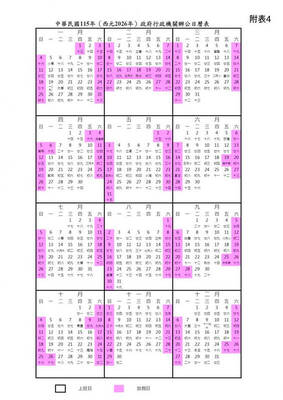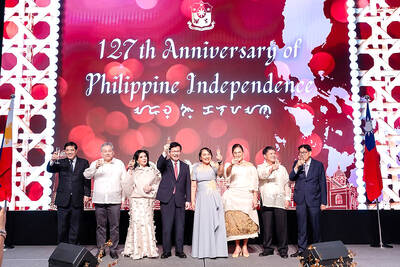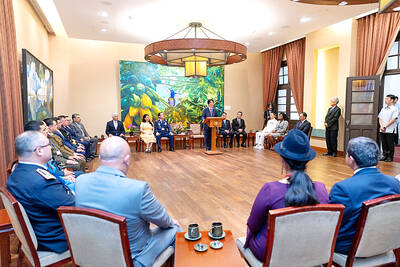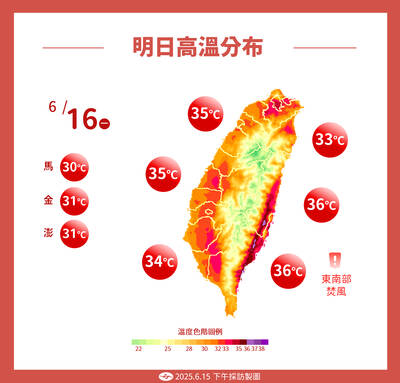Following last month’s amendment to the Organic Act of the Executive Yuan (行政院組織法), dramatic changes to the structure of the government will be implemented in 2012 at the earliest. While some analysts have applauded the move to improve efficiency by downsizing, others warn that the restructuring could have a negative impact on the country’s development.
Jay Shih (施能傑), professor of public administration at National Chengchi University, said what concerned him the most was the creation of a ministry of technology and a council of marine affairs to replace the Coast Guard Administration (CGA), as well as the fact that the central bank would fall under the Cabinet rather than being an independent agency.
An architect of the project during the former Democratic Progressive Party (DPP) government, Shih said the changes proposed by the Chinese Nationalist Party’s (KMT) government and revised by the KMT-controlled legislature “blurred the distinction between a ministry and a council — a ministry being responsible for policy implementation and a council being charged with policy advising, planning and coordination.”
In the case of the technology ministry to be created by merging the National Science Council and the Atomic Energy Council, Shih said this design might not benefit technology development.
Technological progress can be divided into two categories, Shih said: fundamental technology research conducted mostly at universities and overseen by the Ministry of Education, and applied technology in fields of health, agriculture, industry, environmental protection and transportation, among others, administered by a number of government bodies.
“If a ministry of technology takes these over, there is no way it will be able to do the job well,” Shih said.
The DPP government’s proposal was to create a council or commission of technology, which the KMT government changed to a ministry of technology at the request of KMT lawmakers from Hsinchu County who threatened to boycott the bill otherwise.
A ministry is allotted more personnel and greater funding than a council.
Shih said he agreed with setting up a council of marine affairs but that it should not oversee the CGA.
“The number of staffers at the CGA is about 6,000 or 7,000. That isn’t within the scale of a council. If the CGA has to be subordinate to an agency in charge of marine affairs, it should be a ministry, not a council,” Shih said.
Shih said the KMT government had blurred the distinction to make it seem that the nation’s 37 Cabinet-level agencies would be slashed to 27 (14 ministries, eight councils or commissions, three independent institutions, the central bank, two bureaus and the National Palace Museum). Yet the Veterans Affairs Commission (VAC), Overseas Compatriot Affairs Commission (OCAC) and the planned council of marine affairs are ministries in disguise, he said.
“The VAC, in charge of veterans’ hospitals, should either be merged with the Ministry of National Defense or elevated to a ministry, while the OCAC should be incorporated into the Ministry of Foreign Affairs,” he said.
Thomas Peng (彭錦鵬), an associate professor of public administration at National Taiwan University, said the slashed number of ministries, councils and commissions “was still a bit too high,” adding that a normal number of such agencies in an advanced democracy was 13 or 14.
Before the Organic Standard Act of Central Government Agencies (中央行政機關組織基準法) was amended last month, it capped the number of Executive Yuan ministries at 13, councils and commissions at four, and independent agencies at five.
These caps, introduced in 2004, were pushed through by the KMT caucus with the goal of regulating the DPP administration’s restructuring plan.
Peng said the KMT seemed to have backed down from that position.
“I find it regrettable that we didn’t meet the goal. One problem with too many people participating in Cabinet meetings is that it creates barriers to efficient and effective communication,” he said. “Currently there are about 60 people at Cabinet meetings and some of them don’t have a chance to talk.”
Peng said the KMT administration could have streamlined the government further, with agencies in charge of different affairs yet with similar functions being merged. In the case of the council of marine affairs, this should have been incorporated with the ministry of agriculture that will replace the Council of Agriculture, he said.
Opting for a standalone agency for marine affairs subordinate to the Executive Yuan was “a political decision,” Peng said. “This was one of President Ma Ying-jeou’s [馬英九] election pledges and so it has to be delivered.”
“An institution with between 6,000 and 7,000 employees is without exception a ministry, not a council,” he said. “Creating a council and not a ministry to handle marine affairs was just a way to make it seem there is one less ministry.”
Under the KMT’s plan, the executive branch will retain the three agencies that function independently of the Executive Yuan: the National Communications Commission, the Central Election Commission (CEC) and the Fair Trade Commission.
“Independent agencies” are defined in the Organic Standard Act of Central Government Agencies as bodies that require legislative approval for top appointments to be proposed by the premier — an arrangement meant to prevent political meddling and ensure non-partisan operations.
Shih said the government should have taken the opportunity to make the central bank an independent agency because “you cannot expect that anyone can hold the governorship as well as [central bank Governor] Perng Fai-nan [彭淮南].”
Perng, who has been rated as one of the world’s top central bankers by the internationally recognized magazine Global Finance for the past five years, once admonished against overreliance on the central bank to supply revenue to the treasury, which Shih said reflected political meddling.
“A necessary condition for implementing monetary policy leading to price stability is central bank independence. A country’s economy could collapse if its central bank decided to ease or tighten monetary policy to meet political needs. The more independent a central bank is, the better it is for the country,” he said.
But Peng was of the opinion that whether a central bank governor is professional enough matters more than statutory independence.
“To some extent, a central bank needs to meet the government’s agenda for the economy. At the same time, a central bank is not an agency like the CEC that the government would want to control,” Peng said.
James Huang (黃朝盟), a professor at the Department of Public Administration and Policy at National Taipei University, said the changes to the executive branch should be observed to see if they “enhance government efficiency” or render the government “more autocratic” because of inadequate supervision.
Huang was referring to laxer rules on ministries, councils and commissions adjusting their internal units and staff numbers without seeking legislative approval.
Currently, these agencies must submit changes to the legislature as these details are stipulated in their organic acts.
In terms of streamlining personnel, the Act Governing the Total Number of Civil Servants Employed by Central Government Agencies (中央政府機關總員額法), cuts the maximum number of employees to 173,000. Although this is less than the current cap of 223,000, actual total staff right now is below both figures at 164,000. That means the government could still increase staff by 5 percent.
While it is good to “allow flexibility,” “the government should set performance goals so that people can examine whether this plan achieves the anticipated results,” Huang said.
Without evaluation criteria, the changes will be nothing but a “game of numbers,” he said.
“The proposal will cut the number of agencies under the Executive Yuan from 37 to 27 and cap central government employees at 173,000, but what is more important is whether these changes will make the government operate and spend more efficiently,” Huang said.

Taiwan is to have nine extended holidays next year, led by a nine-day Lunar New Year break, the Cabinet announced yesterday. The nine-day Lunar New Year holiday next year matches the length of this year’s holiday, which featured six extended holidays. The increase in extended holidays is due to the Act on the Implementation of Commemorative and Festival Holidays (紀念日及節日實施條例), which was passed early last month with support from the opposition Chinese Nationalist Party (KMT) and Taiwan People’s Party. Under the new act, the day before Lunar New Year’s Eve is also a national holiday, and Labor Day would no longer be limited

Taiwan is to extend its visa-waiver program for Philippine passport holders for another year, starting on Aug. 1, Minister of Foreign Affairs Lin Chia-lung (林佳龍) said on Friday. Lin made the announcement during a reception in Taipei marking the 127th anniversary of Philippine independence and the 50th anniversary of the establishment of the Manila Economic and Cultural Office (MECO) in Taiwan, the Ministry of Foreign Affairs said. The decision reflected Taiwan’s commitment to deepening exchanges with the Philippines, the statement cited Lin as saying, adding that it was a key partner under the New Southbound Policy launched in 2016. Lin also expressed hope

Costa Rica sent a group of intelligence officials to Taiwan for a short-term training program, the first time the Central American country has done so since the countries ended official diplomatic relations in 2007, a Costa Rican media outlet reported last week. Five officials from the Costa Rican Directorate of Intelligence and Security last month spent 23 days in Taipei undergoing a series of training sessions focused on national security, La Nacion reported on Friday, quoting unnamed sources. The Costa Rican government has not confirmed the report. The Chinese embassy in Costa Rica protested the news, saying in a statement issued the same

Temperatures in New Taipei City’s Sindian District (新店) climbed past 37°C yesterday, as the Central Weather Administration (CWA) issued heat alerts for 16 municipalities, warning the public of intense heat expected across Taiwan. The hottest location in Taiwan was in Sindian, where the mercury reached 37.5°C at about 2pm, according to CWA data. Taipei’s Shilin District (士林) recorded a temperature of 37.4°C at noon, Taitung County’s Jinfeng Township (金峰) at 12:50 pm logged a temperature of 37.4°C and Miaoli County’s Toufen Township (頭份) reached 36.7°C at 11:40am, the CWA said. The weather agency yesterday issued a yellow level information notice for Taipei, New